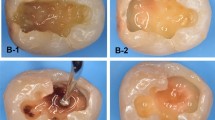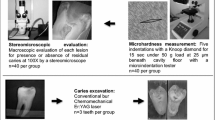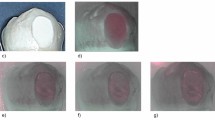Abstract
Aim. This was to compare fluorescence values of dentine remaining after caries removal using chemomechanical systems and conventional rotary methods. Study design: In vitro study. Methods: 30 extracted primary teeth with proximal carious cavities were divided into three groups according to caries removal method: Carisolv®, Papacarie® and conventional low speed rotary burs. Carious (initial) and remaining (final) dentine evaluations were assessed by visual-tactile examination and DIAGNOdent. Transversal microhardness (TMH) of remaining dentine was evaluated. Fluorescence and TMH values were submitted to two-way ANOVA and the post hoc Tukey test (α = 0.05) and Pearson’s linear correlation. Results: Two-way ANOVA revealed that fluorescence values were similar between conventional rotary excavation, Carisolv® and Papacarie® groups (p = 0.0542). No statistically significant differences (p = 0.1147) were found to TMH values. No correlation was found between fluorescence and TMH values (r = −0.0273). Conclusion: All caries excavation methods resulted in similar remaining dentine fluorescence values. No correlation was found between fluorescence values and TMH of remaining dentine.
Similar content being viewed by others
References
Banerjee, A, Kidd, EA, Watson, TF. In vitro evaluation of five alternative methods of carious dentine excavation. Caries Res 2000;34:144–150.
Beeley, JA, Yip, HK, Stevenson, AG. Chemochemical caries removal: a review of the techniques and latest developments. Br Dent J 2000;188:427–430.
Bussadori, SK, Castro, LC, Galvao, AC. Papain gel: a new chemo-mechanical caries removal agent. J Clin Pediatr Dent 2005;30:115–119.
Cederlund, A, Lindskog, S, Blomlof, J. Efficacy of Carisolv-assisted caries excavation. Int J Periodontics Restorative Dent 1999;19:464–469.
Cehreli, ZC, Yazici, AR, Akca, T, Ozgunaltay, G. A morphological and microtensile bond strength evaluation of a single-bottle adhesive to caries-affected human dentine after four different caries removal techniques. J Dent 2003;31:429–435.
Correa, FN, Rocha Rde, O, Rodrigues Filho, et al. Chemical versus conventional caries removal techniques in primary teeth: a microhardness study. J Clin Pediatr Dent 2007;31:187–192.
Ericson, D, Zimmerman, M, Raber, H, et al. Clinical evaluation of efficacy and safety of a new method for chemo-mechanical removal of caries. A multi-centre study. Caries Res 1999;33:171–177.
Fusayama, T. Two layers of carious dentin; diagnosis and treatment. Oper Dent 1979;4:63–70.
Haak, R, Wicht, MJ, Noack, MJ. Does chemomechanical caries removal affect dentine adhesion? Eur J Oral Sci 2000;108:449–455.
Hosoya, Y, Marshall, SJ, Watanabe, LG, Marshall, GW. Microhardness of carious deciduous dentin. Oper Dent 2000;25:81–89.
Hosoya, Y, Matsuzaka, K, Inoue, T, Marshall, GW, Jr. Influence of tooth-polishing pastes and sealants on DIAGNOdent values. Quintessence Int 2004;35:605–611.
Hossain, M, Nakamura, Y, Tamaki, Y, et al. Dentinal composition and Knoop hardness measurements of cavity floor following carious dentin removal with Carisolv. Oper Dent 2003;28:346–351.
Iwami, Y, Shimizu, A, Hayashi, M, Takeshige, F, Ebisu, S. Relationship between colors of carious dentin and laser fluorescence evaluations in caries diagnosis. Dent Mater J 2006;25:584–590.
Kidd, E. The Cartwright Prize. Caries removal and the pulpo-dentinal complex. Dent Update 2000;27:476–482.
Kidd, EA, Joyston-Bechal, S, Beighton, D. The use of a caries detector dye during cavity preparation: a microbiological assessment. Br Dent J 1993;174:245–248.
Krause, F, Braun, A, Eberhard, J, Jepsen, S. Laser fluorescence measurements compared to electrical resistance of residual dentine in excavated cavities in vivo. Caries Res 2007;41:135–140.
Lennon, AM, Buchalla, W, Switalski, L, Stookey, GK. Residual caries detection using visible fluorescence. Caries Res 2002;36:315–319.
Maltz, M, de Oliveira, EF, Fontanella, V, Bianchi, R. A clinical, microbiologic, and radiographic study of deep caries lesions after incomplete caries removal. Quintessence Int 2002;33:151–159.
Maragakis, GM, Hahn, P, Hellwig, E. Clinical evaluation of chemomechanical caries removal in primary molars and its acceptance by patients. Caries Res 2001;35:205–210.
Rafique, S, Fiske, J, Banerjee, A. Clinical trial of an air-abrasion/chemomechanical operative procedure for the restorative treatment of dental patients. Caries Res 2003;37:360–364.
Yazici, AR, Atilla, P, Ozgunaltay, G, Muftuoglu, S. In vitro comparison of the efficacy of Carisolv and conventional rotary instrument in caries removal. J Oral Rehabil 2003;30:1177–1182.
Author information
Authors and Affiliations
Corresponding author
Rights and permissions
About this article
Cite this article
Corrêa, F.N.P., Rocha, R.O., Soares, F.Z.M. et al. Fluorescence of primary dentine after chemomechanical and conventional rotary excavation. Eur Arch Paediatr Dent 9, 126–129 (2008). https://doi.org/10.1007/BF03262623
Published:
Issue Date:
DOI: https://doi.org/10.1007/BF03262623




